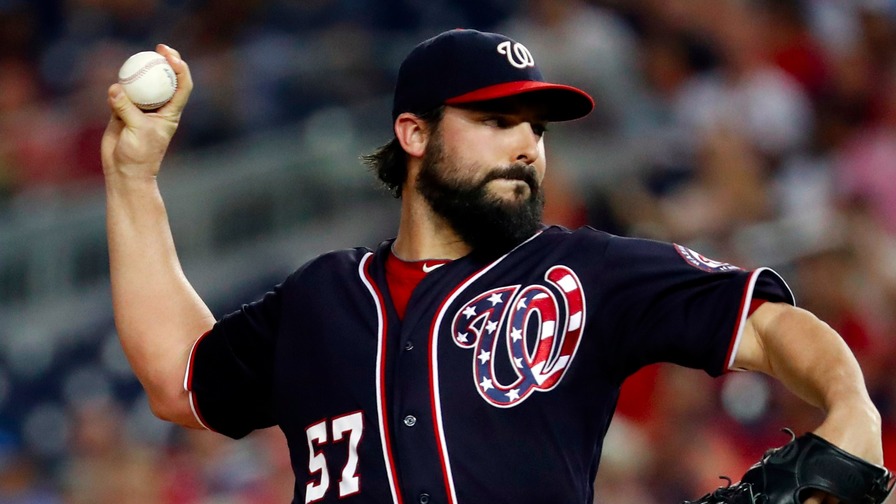Fantasy Baseball: Tanner Roark's Inability to Miss Bats Doesn't Matter

The legendary martial artist Bruce Lee once said, “Mistakes are always forgivable, if one has the courage to admit them.â€
Whether the Washington Nationals are willing to admit that moving Tanner Roark to the bullpen in 2015 was a mistake or not, they redeemed themselves by letting him take the mound for a career-high 33 starts last season.
Roark rewarded the Nationals with 16 wins and a 2.83 ERA in 2016, both of which were career bests, while also tying his career-high in Wins Above Replacement (according to FanGraphs) at 3.2 fWAR. It was an impressive enough of a performance to place 10th in National League Cy Young voting.
However, of the nine pitchers ahead of him, only one had fewer strikeouts than Roark (172), despite only three pitchers throwing more innings than him (210.0). That limits his fantasy baseball value, as his average draft position (ADP) currently sits at 142.47, according to NFBC. However, he'd still be a valuable piece to any team.
Looking ahead to the 2017 season, can Roark maintain his success despite not missing many bats?
Weak Contact=Outs
According to Brooks Baseball, the hardest pitch Roark threw (on average) in 2016 was his four-seam fastball, clocking in at an underwhelming 93.18 mph. This helps explain why his strikeout rate (K%) of 20.1% was a full percentage point below the league average.
It also helps justify his low 8.9% swinging strike rate, which was also below league average (10.1%).
However, Roark didn’t need to strike hitters out at a high rate in order to have success. Instead, he relied on inducing weak contact and limiting hard contact.
The percentage of balls put in play that were hit softly against Roark last season was 23.1%, which was the third highest among qualified pitchers, while the percentage of balls put in play that were hit hard was just 24.3%, which was the lowest.
In other words, instead of missing bats with his pitches, Roark relied on hitters making poor contact to get his outs.
This weak contact also led to a high percentage of ground balls (48.7%, 20th highest), which produced the lowest amount of runs per out at just 0.05, compared to line drives (1.26 runs/out) and fly balls (0.13 runs/out).
Balls that are weakly put into play are more likely to turn into outs, which is why Roark’s .269 BABIP was so low (league average was .298). BABIP is largely reliant on variables outside of a pitcher’s control (i.e. team defense), but they can affect the type of balls put in play, hence Roark’s low number. How exactly was he able to do this?
Five is Better Than One
Roark doesn’t throw hard, but he makes up for this by throwing multiple above-average pitches. This FanGraphs piece touches on this idea and points out he was one of just four qualified pitchers last year to throw five or more above-average pitches in 2016.
His best pitch was a two-seam fastball, which on a PITCHf/x pitch value, was the best two-seamer in baseball last season, while his changeup was fourth-best and his curveball was fifth-best.
With three pitches in the top-5 (along with a slider and four-seamer both in the top-15), it’s easy to see how Roark kept hitters off balance despite the aforementioned lack of swings and misses.
His 61 looking strikeouts were tied for the seventh most last season, suggesting hitters often didn’t know what was coming. This total is all-the-more impressive considering every pitcher ahead of him (or tied) on this list had a higher K% and just two had a lower swinging strike percentage.
Can He Repeat in 2017?
Only eight pitchers threw more pitches last season than Roark, so you might assume to see some fatigue. However, he still only has 573.1 career innings in the majors under his belt, so he should be able to maintain another heavy workload.
More importantly, his ability to throw five different pitches with success suggests his unconventional approach (compared to dominant flamethrowers) is sustainable. Roark relied on both his curveball and changeup more last season than compared to his career averages, a trend that should continue in 2017.
The right-hander has proved he deserves to be considered among the game’s best pitchers. His ERA+ last season was 148 – in other words, 48% better than league average – which was higher than teammate and 2016 Cy Young award winner, Max Scherzer.
Roark’s failure to tally big strikeout numbers means that he has to rely on luck and his team’s defense in order to be successful, and it's also the reason why his fantasy value is a bit limited. While it would be easy to assume his BABIP regresses in 2017, he has the arsenal to switch luck in his favor, unlike strictly contact-type pitchers.
















